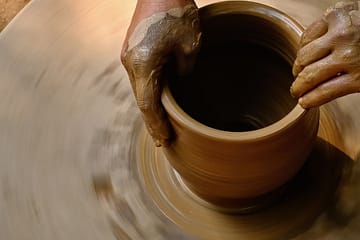If you feel like you are slogging through late winter, mucking through your healing or overwhelmed by all you want to learn, this blog is for you. This week I’m sharing a post written by Elizabeth Jarrett Andrew (also my partner in life) about falling into the bigger dance of life, writing craft, and the self-consciousness that is inevitably on the way to consciousness. May it encourage you to keep showing up to your practice (dancing, writing, meditation etc.) because eventually we may learn the art of “walking on air.†– Emily
 When my partner Emily teaches a traditional circle dance to a group of newbies, they go through a predictable progression. First, they’re so uncomfortable they trip over their feet. They talk nervously, drawing attention away from their awkwardness. Sometimes they give up. But Emily’s a patient teacher and her dances are simple, ancient, and usually repetitive, so those who stick with it eventually fall into a pattern and begin enjoying themselves.
When my partner Emily teaches a traditional circle dance to a group of newbies, they go through a predictable progression. First, they’re so uncomfortable they trip over their feet. They talk nervously, drawing attention away from their awkwardness. Sometimes they give up. But Emily’s a patient teacher and her dances are simple, ancient, and usually repetitive, so those who stick with it eventually fall into a pattern and begin enjoying themselves.
Then, if the dancer repeats these steps over weeks and months, he or she forgets the steps entirely and enters the dance. I’m not much of a dancer but even I have experienced my self-consciousness release into consciousness and then fall away entirely.
I’m interested in how this happens for writers, too. Seamus Heaney describes it as “walking on airâ€: “We must teach ourselves to walk on air against our better judgment.â€Â Lately in my own writing practice I’ve experienced it as the art of forgetting. I’ve been writing long enough that I’ve gotten a pretty good grasp on the elements of craft; I’ve some skills under my belt. What if it’s time to forget all this and enter the story?
I’m reminded of a disastrous class I taught at the Loft Literary Center a few years ago. The course was an introduction to revision, and that evening’s lesson was on transitioning between reflection and narration. At first students moved easily between story and exposition; it’s something we humans naturally do when we tell each other stories. But when I called attention to the distinction between our character selves and narrator selves—when I showed them how they were transitioning between these voices and what effect it had on the reader—they got stymied. Self-consciousness made it impossible to write well. The class got disgruntled, and the evening ended with fifteen writers writing worse than when they arrived.
But this is our progression when learning an art, and (I suspect) when living life: First we’re unconscious, then we’re self-conscious, and then we’re aware of being self-conscious, which is truly agonizing. Only then can we come into consciousness and make conscious choices that shape our lives. My students needed to recognize that they were using a technique before they could choose to use this technique. Intention, not default, makes art. And intention makes life itself deliberate and artful.
But at some point even intention sinks down into muscle memory and the body takes over, moving in a dance far bigger than itself. At some point consciousness can fall away, if we let it. We can walk on air. I don’t know yet, but I’m curious about where that will take me and my writing.
Elizabeth Jarrett Andrew
Practice, practice, practice.
Build the muscle/body/heart memory that can help you drop into something much bigger. Healing Waters Qigong practice group meets every Wednesday. Cultivate joy and life energy through the sacred healing art of a weekly dance practice.
Need a boost?
I offer one-on-one sessions.


